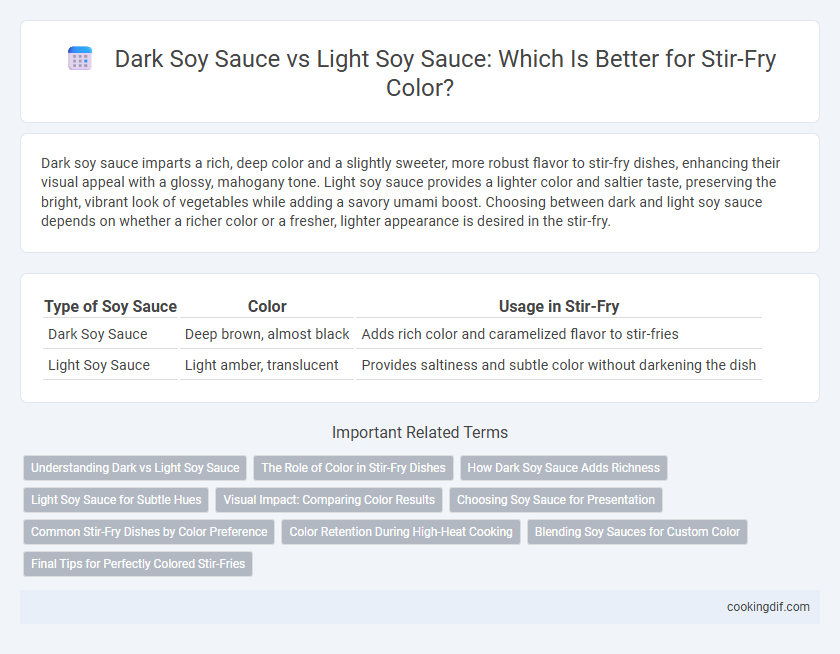Dark soy sauce imparts a rich, deep color and a slightly sweeter, more robust flavor to stir-fry dishes, enhancing their visual appeal with a glossy, mahogany tone. Light soy sauce provides a lighter color and saltier taste, preserving the bright, vibrant look of vegetables while adding a savory umami boost. Choosing between dark and light soy sauce depends on whether a richer color or a fresher, lighter appearance is desired in the stir-fry.
Table of Comparison
| Type of Soy Sauce | Color | Usage in Stir-Fry |
|---|---|---|
| Dark Soy Sauce | Deep brown, almost black | Adds rich color and caramelized flavor to stir-fries |
| Light Soy Sauce | Light amber, translucent | Provides saltiness and subtle color without darkening the dish |
Understanding Dark vs Light Soy Sauce
Dark soy sauce is thicker and offers a rich, deep color that enhances the visual appeal of stir-fry dishes, while light soy sauce provides a lighter, amber hue and is primarily used for seasoning without overpowering the dish's natural flavors. Dark soy sauce contains molasses or caramel, contributing to its sweeter taste and darker coloration, whereas light soy sauce is saltier and thinner, making it ideal for marinating and adding umami depth. Choosing between dark and light soy sauce depends on whether you want a bold, glossy finish or a subtle, savory undertone in your stir-fry.
The Role of Color in Stir-Fry Dishes
Dark soy sauce imparts a rich, deep brown color to stir-fry dishes, enhancing visual appeal and signaling a robust flavor profile. Light soy sauce offers a lighter amber hue, allowing the natural colors of vegetables and proteins to remain vibrant while providing a salty, umami taste. Balancing dark and light soy sauces can optimize both color and flavor, creating visually striking and appetizing stir-fry presentations.
How Dark Soy Sauce Adds Richness
Dark soy sauce adds a deep, rich color to stir-fry dishes, enhancing their visual appeal with its thick, syrupy texture that coats ingredients evenly. It imparts a subtle sweetness and umami depth, distinguishing it from the lighter, saltier light soy sauce commonly used for seasoning. Chefs rely on dark soy sauce for a robust, caramelized finish that intensifies both flavor and appearance.
Light Soy Sauce for Subtle Hues
Light soy sauce delivers a delicate amber tone that enhances stir-fry dishes with subtle, natural hues without overpowering the ingredients. Unlike dark soy sauce, which imparts a deeper, richer color and can dominate the visual presentation, light soy sauce preserves the vibrant colors of vegetables and proteins. Its lighter consistency and flavor profile support a balanced, visually appealing stir-fry.
Visual Impact: Comparing Color Results
Dark soy sauce imparts a rich, deep brown color to stir-fry dishes, creating a visually striking and glossy finish that enhances the overall presentation. In contrast, light soy sauce produces a lighter, amber hue, preserving the natural colors of vegetables and proteins for a fresher appearance. Chefs often combine both to balance intense coloration with vibrant ingredients, achieving optimal visual appeal in stir-fry meals.
Choosing Soy Sauce for Presentation
Dark soy sauce imparts a rich, deep color to stir-fry dishes, enhancing the visual appeal with its thicker consistency and caramelized sweetness. Light soy sauce offers a lighter, reddish-brown hue that preserves the natural colors of vegetables and proteins while adding a salty umami flavor. Choosing between dark and light soy sauce depends on the desired presentation: dark soy sauce for a glossy, intense finish, and light soy sauce for a brighter, more vibrant appearance.
Common Stir-Fry Dishes by Color Preference
Dark soy sauce adds a rich, deep brown color ideal for dishes like beef and broccoli stir-fry, enhancing visual appeal and flavor intensity. Light soy sauce imparts a lighter, amber hue preferred in chicken and vegetable stir-fries, preserving the natural colors while providing savory umami. Common stir-fry color preferences guide recipe choices, balancing appearance with taste to achieve vibrant, appetizing meals.
Color Retention During High-Heat Cooking
Dark soy sauce provides a richer, deeper color to stir-fry dishes and maintains its hue better during high-heat cooking due to its thicker consistency and caramelized sugar content. Light soy sauce, while lighter in color and saltier in taste, tends to fade more quickly when exposed to intense heat, resulting in less vibrant dishes. For optimal color retention and visual appeal in stir-fry recipes, dark soy sauce is the preferred choice.
Blending Soy Sauces for Custom Color
Dark soy sauce imparts a rich, deep color to stir-fry dishes, enhancing visual appeal with its thicker texture and slightly sweet flavor. Light soy sauce offers a lighter hue and saltier taste, providing balance without overwhelming the dish's natural colors. Blending dark and light soy sauces allows for a customized color intensity and flavor depth, achieving the perfect stir-fry appearance and taste.
Final Tips for Perfectly Colored Stir-Fries
Dark soy sauce delivers a rich, deep color to stir-fries, enhancing visual appeal with its thicker texture and slightly sweeter flavor. Light soy sauce provides a lighter color and saltier taste, preserving the vibrancy of vegetables without overpowering the dish. For perfectly colored stir-fries, use dark soy sauce sparingly to avoid overly dark hues and balance with light soy sauce to maintain brightness and layered flavor.
dark soy sauce vs light soy sauce for color Infographic

 cookingdif.com
cookingdif.com